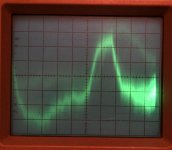A lot of noise ends up in the tweeters.......also the low frequent from rectifiers etc....which have some "nasty" overtones that is very audible in the tweeter.
I will think about the 8 ohm 🙂 ......but I also want to hear the "pling" sounds from guitar strings etc....
The ACA's are back on the shelf now but they did a very good job.
I will think about the 8 ohm 🙂 ......but I also want to hear the "pling" sounds from guitar strings etc....
The ACA's are back on the shelf now but they did a very good job.
you can always put 8R in series with tweeters....... noise gone!

Or just disconnect it 🙂
It can also be a dangerous exercise to put ear only few cm from dome if a bad spike suddenly got into the system.....it may cause permanent ear-damage 🙂
Those having +105 dB horn tweeters.....it may be even more dangerous.....
Have you checked your hearing at high frequencies using test-CD or generator?
I can hear 12 kHz but 16kHz seems to be almost gone.....
Maybe tweeters are "overrated" for middage or above people......
Those having +105 dB horn tweeters.....it may be even more dangerous.....
Have you checked your hearing at high frequencies using test-CD or generator?
I can hear 12 kHz but 16kHz seems to be almost gone.....
Maybe tweeters are "overrated" for middage or above people......
Amp is now fully assembled with top cover on and both channel showed 20.08 VDC at the test point after warm-up.
Will conclude that problem has been solved. Also tonight both channels was very quiet (and equal).
After experiment with passive pre I amp back using active (it always ends up that way even that first listening impression is very good using passive pre but after a while.....something is missing).
Will conclude that problem has been solved. Also tonight both channels was very quiet (and equal).
After experiment with passive pre I amp back using active (it always ends up that way even that first listening impression is very good using passive pre but after a while.....something is missing).
passive pre is important reference
good quality preamp must have same amount of details, but also bringing improved dynamics
if both of these aren't there, preamp eeznoogood
good quality preamp must have same amount of details, but also bringing improved dynamics
if both of these aren't there, preamp eeznoogood
yup
Chede just show that word is not new 🙂
it just depends how you write it
Kalif instead of Kalif

Chede just show that word is not new 🙂
it just depends how you write it
Kalif instead of Kalif

I could probably find a serial combination that works.
Would be difficult to make it so it also looks good.
I hope a new trimmer solves it which should arrive next week.
I would try the fixed resistor approach while you wait if you can get the value right.
passive pre is important reference
good quality preamp must have same amount of details, but also bringing improved dynamics
if both of these aren't there, preamp eeznoogood
With the relative low gain of VFET amp it is possible to just connect DAC out directly to VFET amp just for a reference test (it will be quite loud then). VFET amp is as easy to drive as preamp. Then pure VFET sound can be evaluated.
An Edcor with multiple outputs could be fun and just have a selector as Vol. control.....
The output noise from VFET itself is very low. A preamp will always add some noise......
I would try the fixed resistor approach while you wait if you can get the value right.
New trimmers arrived and a new one installed and problem solved. No problems since then.
I can now say that "noise" is back in right channel!
So trimmer was not the issue.
If we say it is flicker-noise in VFET. I know noise is random but can such noise suddenly stop for some seconds / minutes and then come back and change in intensity. Sometimes audible also in mid-range speaker?
But only with ear close to speaker units.
I will check with oscilloscope to see if it is possible to see anything but my scope may not be sensitive enough.
So trimmer was not the issue.
If we say it is flicker-noise in VFET. I know noise is random but can such noise suddenly stop for some seconds / minutes and then come back and change in intensity. Sometimes audible also in mid-range speaker?
But only with ear close to speaker units.
I will check with oscilloscope to see if it is possible to see anything but my scope may not be sensitive enough.
What I see on scope on both channels is that ground noise looks the same. I measure at 1mV/div with X1 probe. Probe probably picks up also from environment as I see 2mV pp high frequency noise.....or so.
Difference is that L-channel.....the horizontal midline is of signal is stable while R-channel the signal jumps up and down (very random).....lets us say.....1-2 mV and this fits with the "clicking" or "poping" noise I hear with ear close to units.
Difference is that L-channel.....the horizontal midline is of signal is stable while R-channel the signal jumps up and down (very random).....lets us say.....1-2 mV and this fits with the "clicking" or "poping" noise I hear with ear close to units.
I have tried to make a small MP4 video showing the difference between my L and R channel. The "ground noise" is the same but the low frequency jumping up and down of the signal you see is the difference. These jumping up and down is heard as the "cracks" or "pops" with ear close to tweeter and it is also audible in mid-range. Something I have never been used to hear.
Measurements are with shorted input and sensitivity is 1mv/div. So "jumps" are about 1mV which is audible in 94 dB speakers. 3-4 mV RMS noise is audible at listening position 3m away.
Next component to change is as far as I remember the optocoupler. But could a bad one cause this kind of noise?
Is it the VFET itself that does this?
If I measure on L-channel the jumping up and down is a least 10 times less.
Measurements are with shorted input and sensitivity is 1mv/div. So "jumps" are about 1mV which is audible in 94 dB speakers. 3-4 mV RMS noise is audible at listening position 3m away.
Next component to change is as far as I remember the optocoupler. But could a bad one cause this kind of noise?
Is it the VFET itself that does this?
If I measure on L-channel the jumping up and down is a least 10 times less.
Attachments
I can add that something we hit a "storm" and then the "jumps" are 3-4 mV and signal almost jumps out at screen. And then suddenly it is almost silent......
It is not a bad connection.....this has been checked and solder joints re-flowed etc....so I don't want to discuss bad connections 🙂 .....only if is it inside a device. Have also verified that it is not the FE-board.....
It is not a bad connection.....this has been checked and solder joints re-flowed etc....so I don't want to discuss bad connections 🙂 .....only if is it inside a device. Have also verified that it is not the FE-board.....
In the moment my ears are away from speakers and scope are my "ears". Scope seems to be even more sensitive than my ears......
I slowed down the sweep to 20 ms pr. cm and captured one of the "jumps". Sensitivity is still 1mV/div.
So here you can see a "pop".....or "crack".....
What is the origin of this?
If it is the VFET itself I might "chill" a bit...... 🙂
But even if I pretend is it a tube......I can say my 300B amp is more silent than this 🙂
I slowed down the sweep to 20 ms pr. cm and captured one of the "jumps". Sensitivity is still 1mV/div.
So here you can see a "pop".....or "crack".....
What is the origin of this?
If it is the VFET itself I might "chill" a bit...... 🙂
But even if I pretend is it a tube......I can say my 300B amp is more silent than this 🙂
Attachments
- Home
- Amplifiers
- Pass Labs
- VFET amp Bourns trimmer exchange


 Please Meper don't give up,
Please Meper don't give up,